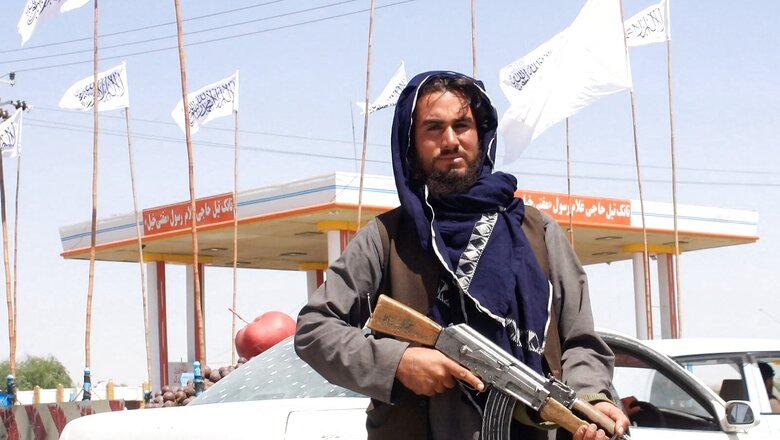
views
Late last year when newly elected US President Joe Biden said, ‘America is back’, little did many realise that his definition of ‘America is back’ would also result in swiftly bringing back Taliban to the helms of affair in Afghanistan and sow seeds for a new era of instability in South Asia with deep potential ramifications for the rest of the world.
With Taliban having almost taken over Kabul, with province after province in Afghanistan having succumbed in front of them, with Afghan National Army, trained by US with much fanfare, meekly capitulated in spite of superior weapons and numerical advantage, with millions in Afghanistan, shocked by the sudden desertion of US and blitzkrieg like advances of Taliban, desperately looking for ways to exit the country, with millions more already having escaped from fallen cities to save their lives and honour from the vicious brutality and lust of Taliban terrorists, one is just compelled to wonder if the western rhetoric about ‘humanity’, ‘democracy’, and ‘human rights’ are just for playing to the gallery or do they ever mean anything for real.
After all, it was the US that for months had negotiations with Taliban in Doha, for a hypocritical peace deal with a terrorist organisation, which in reality, was nothing but a face-saving exit certificate desperately sought by US, since it simply wanted to leave Afghanistan with the tail neatly placed between two legs. Future of people of Afghanistan be damned.
America’s Trillion-Dollar and Two-Decade-Long War: What Did It Achieve?
In retrospect, one is left with no option but to pose some serious questions to the American policymakers. If after nearly twenty years of bombing missions and spending trillions of dollars in Afghanistan, US and its allies have not been able to defeat the ragtag Taliban, then should one not question the justification or efficacy of such campaigns and whether their intent to obliterate Taliban and terrorism, was for real or not? For almost two decades, the US led anti-terror operations went on in Afghanistan. From the infamous Kunduz airlift that allegedly allowed Pakistan to evacuate its top military advisors and Taliban leaders from Afghanistan to Pakistan in November 2001, to Taliban literally steamrolling into Kabul in 2021, one wonders what was the real objective of America’s much famed ‘Global War on Terror’ if eventually US was negotiating a face-saving exit with that very Taliban, and was apparently okay with the prospect of Taliban returning to power. Is Taliban not a terror organisation for US anymore?
Going by the general argument of withdrawal from Afghanistan being for the purpose of focusing more on China, one is again then forced to wonder that if the US, with all the arsenal at its disposal, could not defeat the Taliban in two long decades, then how can the world trust the Americans to stand for the democratic world and take the autocratic, hegemonic China head on?
Post WWII, Has Any American War Campaign Ended Up with Positive Outcomes?
The fundamental question, however, is this: Did the US win any war decisively with positive outcomes ever since the end of World War II? Even in case of World War II, however, much Hollywood and western narratives may try to portray otherwise, the real war on ground for years was fought by the Soviets. The Americans entered the war much later. Post World War II, the Cold War started. The 1950s saw the occurrence of the three year-long Korean War in which Truman’s America participated with much élan in support of South Korea and against Communist North Korea. Almost 70 years since then, China-backed North Korea continues to exist, if not thrive, but with a whole array of ballistic missiles in its arsenal.
The Vietnam Saga
By 1955, the Vietnam War had started and US shifted its focus from Korean Peninsula to Vietnam. For nearly two decades since then, the mighty American armada waged a disproportionate war against the Viet Cong, used everything from cluster bombs to guided bombs to fuel air explosives such as Napalm bombs. Even then, the Viet Cong with their jungle warfare tactics proved more than a match for the Americans. Eventually, the American troops, exhausted and devastated, exited Vietnam by 1973, and without an iota of victory in their sight, while North and South Vietnam merged in July 1976 to become the Socialist Republic of Vietnam. Once again, US did not win.
Saddam Hussein, Afghan Mujahids were Armed by the US in 1980s
Throughout the 1980s, the US and its allies such as the UK, wholeheartedly supported Saddam Hussein in Iraq and the Mujahideens in Afghanistan. US needed Saddam Hussein to defeat Ayatollah Khomeini’s Islamic Revolutionaries in Iran and Mujahideens to wage war against the Soviet rule in Afghanistan.
Donald Rumsfeld, then a Special Envoy of President Reagan and later a US Defence Secretary, met Saddam Hussein in December 1983. According to a Newsweek article, quoted in a Congressional Record and made available in the website of Federation of American Scientists (FAS), ‘The meeting between Rumsfeld and Saddam was consequential: for the next five years, until Iran finally capitulated, the United States backed Saddam’s armies with military intelligence, economic aid and covert supplies of munitions’.
US turned a blind eye to many a thing that Saddam did, including use of mustard and sarin gas on Iranian Army as well as the killing of nearly 5,000 Kurds in the genocidal chemical attack on the Kurdish village of Halabja. For US, defeat of Iran was more important than anything else.
In the same league, America’s arming and active support for Mujahideens to wage war against Soviet Union, in many ways sowed the seeds of the present-day radical Islamist terrorism that has plagued the world for decades now. CIA’s rather infamous Operation Cyclone, the code name for arming and funding of the Mujahids from 1979 to 1989, with active support from MI6 and ISI, created a potent force that took on the Soviet regime in Afghanistan.
US Trained Mujahids Spawned Taliban, al-Qaeda and likes of Osama Bin Laden
Indoctrinated with a violent radical ideology to wage ‘holy war’ or jihad against the Communists in Afghanistan, and for which they were willing to happily embrace death, armed with thousands of tons of American weapons and munitions, along with military style training, the Mujahids who fought in Afghanistan, a significant number of whom came from Middle East and Pakistan, became a major potent radical force that gave birth to Taliban, and the likes of Osama Bin Laden and al-Qaeda later. Once Soviets were ousted from Afghanistan, the radicalised lot turned their attention towards ‘infidel’ West and their jihad against the civilised world, including suicide terror attacks in major cities across the world started with impunity.
According to a paper titled, ‘The Taliban in Afghanistan’, published by Council on Foreign Relations, ‘The group was formed in the early 1990s by Afghan mujahideen, or Islamic guerilla fighters, who had resisted the Soviet occupation of Afghanistan (1979–89) with the covert backing of the CIA and its Pakistani counterpart, the Inter-Services Intelligence directorate (ISI)’. Photographs of US President Ronald Reagan with Mujahideen leaders in 1980s say a lot about US foreign policy and the monsters it has often ended up creating. As a byproduct, the US also empowered the rogue state of Pakistan that eventually became the ‘Terror Factory’ of the world.
Saddam and Mujahids Turned Evil in the Eyes of US: Time to Play ‘War’
The First Gulf War started in January 1991, barely a few years after the US had turned a blind eye to Saddam’s use of chemical agents on Iranians and Kurds. If earlier, US wanted Iraq to defeat Iran, now it was time for US to change position and do all it could to cut a belligerent Saddam down to size, the same one it had mentored, incubated and emboldened for a decade. America’s gigantic military industrial complex got an unprecedented opportunity to showcase its new age weapons, and of course, to mint money.
From Apache and Cobra attack helicopters to F-15, F-16 and F-111 combat jets, from A-10 gunships, B-52 and F-117 bombers, to Tomahawk cruise missiles, the Americans left no air platform untested on Iraqi soil. Eventually, a substantial portion of the famed Iraqi Army was almost decimated along with most of Baghdad. Yet surprisingly, the Americans allowed Saddam Hussein to remain at the helm of affairs in Iraq in spite of the overwhelming defeat and loss of face that he suffered at the hands of Coalition Forces.
Not just that, shockingly, after the Gulf War ended, Saddam resorted to brutal crushing of the uprising in Iraq. The armed uprising was often termed as Sha’aban Intifada or National Uprising. The persecuted Shias and Kurds of Iraq, tormented for decades by Saddam’s regime, saw a glimmer of hope when the Gulf War started and initiated a popular uprising in Iraq on the hope that the US-led Coalition Forces would rally behind them to oust Saddam regime. But the US left them high and dry. Once Saddam’s Army surrendered in Kuwait, the US had no interest in what was happening inside Iraq. Saddam continued with his reprisals inside Iraq. The US won the war but Saddam firmly remained on the throne of Iraq.
Like Afghanistan, US Messed Up in Iraq too that Gave Birth to ISIS
Almost nearly a decade after the Gulf War had started, the 9/11 terror attack took place and US was back in Afghanistan. This time it was there to wage war against the very same Mujahideens which it had armed, trained and radicalised in the past. George W Bush, then US President, also went back to Iraq to conclude the unfinished agenda of his father. America’s great ‘Global War On Terror’ thus started. Why they went to Iraq is still a mystery because the Baathist regime of Saddam Hussein might have been rabidly brutal, however, it was anything but a supporter of al-Qaeda. Also, the US could never find the imaginary ‘Weapons of Mass Destruction’ in whose pretext they waged war against Iraq again.
Eventually, the US forces did capture Saddam Hussein and hanged him till death but could never bring back the elusive peace and stability in Iraq. The country got mired in the worst kind of sectarian violence. The Americans failed to understand the cultural and societal complexities of Iraq. It imposed a puppet regime in Baghdad. The Shias became much stronger and Iran’s leverage on Iraqi affairs increased more than ever before. The Sunnis felt sidelined as well. The void that the Americans created through their bloody war in Iraq and leadership crisis, eventually acted as a bottomless pit for germinating violent radicalised elements.
A decade after 9/11 terror attack, as the Americans were preparing to exit the Iraqi theatre after another botched up operation, from the churning of the internal sectarian turmoil and sheer absence of political leadership, ISIS, a vicious Salafi ideology driven terror organisation, in its new avatar, was born whose brutality made even al-Qaeda look like a moderate entity. Since 2013-14, ISIS unleashed the worst kind of genocidal mayhem and civil war-like situation in several countries across Middle East and North Africa, in addition to inspiring its followers to execute lone wolf terror attacks in several major cities of Europe. In between, the US botched up in Libya as well. Post the elimination of Gaddafi, the state has been mired in a similar civil war-like situation and has become a hotbed of radical Islamist groups.
The Void in Afghanistan is Similar to What the US Created in Iraq as it Exited
The situation in Afghanistan today is exactly the kind of ecosystem that US left behind in Iraq. Therefore, it goes without saying that in the times to come, Afghanistan under Taliban regime would, like a magnet, attract radicalised Islamist elements from across the world. They would emerge under new banners and in the next half a decade, one should not be surprised if a new spate of global terror, the kind that was unleashed by ISIS or al-Qaeda, is again witnessed by the world, along perhaps with attempts of horrendous terror attacks, much on the lines of 9/11 or 26/11. The US perhaps then would again come forward for another hypocritical ‘War on Terror’ and the saga would repeat itself.
The Shape of Things to Come in Afghanistan
Taliban, for all its pretense of being more measured and seeker of peace now, at core remains a horrendous and viciously abusive terror organisation that would eventually impose Sharia laws in Afghanistan and torment the Afghan women in the worst way possible. Videos of Taliban snatching young girls from families to use them as sex slaves expose their true nature behind the veneer of PR campaign that they have recently orchestrated to gain acceptability.
The Taliban of today is flush with more funds, have access to sophisticated weapons and have an air of invincibility having forced the Afghan National Army to capitulate. The rise of Taliban would also mean Pakistan in some ways getting back control of what they often deemed to be their strategic backyard, i.e. Afghanistan. Whether the rise of Taliban 2.0 would make Tehreek e Taliban launch more attacks on Pakistan and spawn terrorism in neighbouring Uzbekistan, Tajikistan and Turkmenistan or whether Pakistan’s deep state would use the jihadis spawned by Taliban’s Afghanistan to attempt more mayhem in India, is a mystery only time would unravel. However, it is also only a matter of time before another Northern Alliance kind of organisation is created to take on the Taliban. The saga of cycle of violence in Afghanistan is far from over.
The Indian Options: Limited but Clear Cut
For India, there is not much option left but to fortify even more its counter terror infiltration grid and create a more robust counter terror response mechanism. Last time, the Americans left Afghanistan almost three decades back, leaving behind an army of trained Mujahids to run amuck, India had to bear its brunt as the flames of terrorism traversed across the Hindukush to ignite fires of militancy in restive Kashmir. One has to remember that the first wave of Jihadis unleashing terrorism in Kashmir were from Afghanistan, channelised by Pakistan to bleed India. Three decades down the line, India might be far more prepared to deal with such eventualities, and both Pakistan and Taliban might be aware of the consequences of attempting a repeat of 1989, still India would have to remain vigilant and cautious.
It is Time for the US to Introspect
On a concluding note, the Afghan quagmire, and America’s literal desertion of Afghanistan put severe question marks on Joe Biden’s foreign policy acumen. His leadership and credibility, both at home and abroad would be under intense scrutiny. But he is not alone to be blamed. Trump would have done the same.
Nevertheless, it is time for the US to realise that its ‘shock and awe’ battle strategy may be impressive for showcasing its sophisticated military arsenal, however, when it comes to winning ‘hearts and minds’, or winning battles on ground, it has a lot to learn from countries such as India or Russia. The manner in which the Afghan National Army capitulated in front of Taliban, in spite of its quantitative and qualitative superiority, puts serious question marks on the ability of the US to train foreign soldiers and develop military leadership skills. What had happened to Iraqi Armed Forces, trained by the US, in the face of ISIS onslaught, was no different.
Also, the manner in which Ashraf Ghani surrendered and showed sheer lack of political or strategic will to fight Taliban even when an overwhelming majority of Afghan people did not want the Taliban to return to power, exemplifies America’s flawed policy of experimenting with its false notion of democracy as a panacea, and setting up puppet regimes that often do not stand the test of time when push comes to shove. The puppet simply refused to perform when its masters stopped pulling strings from behind, and was more interested in a safe exit route for himself like his masters.
For two decades, the US and its allies showed a dream of modern life to the people of Afghanistan. When Afghan people started embracing it with full commitment, the US simply just pulled the rug from beneath their feet and pushed them back into the arms of dark age again. From Iraq to Libya to Afghanistan, the story remains the same. USA’s ‘Operation Enduring Freedom’, the official name for war on terror in Afghanistan, turns out to be anything but about endurance of freedom. It is indeed time for the US to introspect.
The author is a geopolitical analyst. The views expressed in this article are those of the author and do not represent the stand of this publication.
Read all the Latest News, Breaking News and Assembly Elections Live Updates here.




















Comments
0 comment